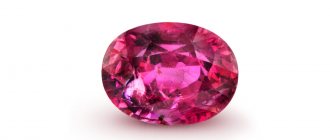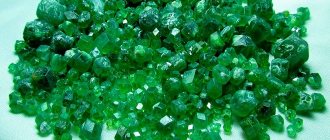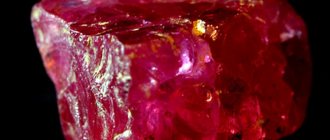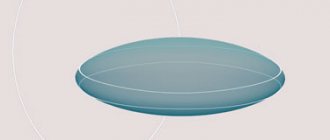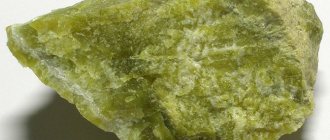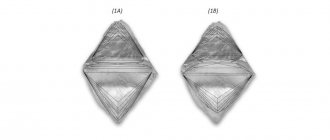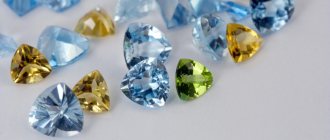Synthetic gemstones
This group includes complete analogues of natural stones. They have a similar crystal lattice, since their cultivation imitates the natural process of stone formation. The only difference is that in the laboratory and in industrial settings the stones are grown in a few days or weeks. Initially, crystal synthesis technologies were expensive, but today synthetic gemstones are cheaper than their natural counterparts. At the same time, they can have maximum purity and color saturation, which is rarely found in nature. Stones in this group receive the names of natural minerals with the addition of “synthetic” or “grown”: “synthetic ruby”, “grown emerald”.
Are artificially grown stones fake?
An ordinary person will never be able to distinguish a synthetic stone from a natural one, and if a seller passes off an artificial stone as a real one, of course it will be considered a fake.
The creation of artificial stones is in no way a substitution, but only an opportunity for an alternative choice.
Synthetic stones with a good reputation can, like precious stones, appreciate in value and become in demand, and rare ones can even become collector's items. In general, we can conclude that synthetic gems can coexist peacefully with natural ones - rather, complement each other rather than compete. Several types of artificial gemstones enter the modern jewelry market. Synthesized (grown) precious stones; synthesized crystals of compounds of the group of rare earth elements that do not occur in nature, for example cubic zirconia (imitation diamond); imitation of precious stones made from famous glass, which are mainly used in costume jewelry and are easily distinguished from precious stones by their low hardness “by eye”; as well as doublets - composite gemstones glued together from two different minerals.
Aquamarine.
This mineral is very similar to topaz in color and even inclusions. However, topaz does not have inclusions characteristic of aquamarine, resembling a white chrysanthemum. Aquamarine is also imitated with both ordinary glass and less valuable minerals: synthetic spinel, artificial quartz. You can distinguish them from real aquamarine simply by looking at the stone from different angles: aquamarine slightly changes its color scheme, but there is no imitation.
There are no synthetic aquamarines on the jewelry market. The imitations sold under this name are actually bare spinel or glass. All glass imitations seem warmer to the touch, unlike real stone. If the stone is not set in the frame, you need to hold it with tweezers (so as not to heat it with your hands) and touch it with the tip of your tongue - the stone should be cold.
Alexandrite
This is a very rare stone, large examples are unique. Alexandrite jewelry is very expensive. Alexandrites are counterfeited with rubies with the properties of the multi-colored mineral in different lighting conditions. This effect is called pleochroism. Also counterfeited with glass.
Amethyst
Amethysts that are pure and bright in color are precious. The properties of real and synthetic amethyst are very similar and it is not easy to distinguish them. Artificial minerals are now used by jewelers quite often, since they are produced on an industrial scale; in contrast, colored cubic zirconia like amethyst can be recognized: they heat up faster, this can be determined, for example, by applying them to the face.
Turquoise
It is even counterfeited with plastic, which of course is not as porous and smooth as the real thing. Imitation glass has small bubbles in its structure, which cannot be said about real stone. Also, by refining in the laboratory, low-grade turquoise is transformed into high-quality turquoise. There they can glue small particles of turquoise, process them with temperature, and much more. Enamel, compressed turquoise powder, and the Howlite mineral are also passed off as turquoise. Howlite becomes turquoise-like when colored. In general, natural turquoise without defects is practically impossible.
Crystals made from crushed turquoise with glue are difficult to distinguish from real ones. And only over time do the fakes acquire a dirty tint.
Rhinestone
Artificial rock crystal is made from quartz mixed with lime and soda. Dishes are also made from this mineral. Stone is also counterfeited with simple glass. The difference between real rock crystal is that it does not have high thermal conductivity, unlike fakes. Peering into the inside of a natural mineral, you can see a slight haze there. Rock crystal shines, like glass, without shimmering with rainbow colors, unlike diamond.
Currently, quartz is grown hydrothermally in steel autoclaves. The solvent for natural quartz raw materials is solutions of hydroxides and carbonates of alkali metals - sodium or potassium in a concentration of 3 to 15%. The synthesis is carried out at a pressure of 50-150 MPa at a temperature of 250-450 °C.
For seeds, plates or rods of natural quartz are used, which are oriented parallel to the crystallographic planes (0001) and (1120). The crystal growth rate is up to 0.5 mm/day.
It was found that if iron is added to potassium melts of the initial solution with a low potassium concentration, then brown crystals are formed; at a higher potassium concentration, green crystals are formed.
Real rock crystal is always cool to the touch.
Grenades
Garnets are among the precious stones that have the power of magnetic attraction. Some other stones are also determined by their magnetism. To do this, the stone (pre-weighed) is placed on a tall plug (to separate it from the metal pan of the scale), which is placed on the pan. Once the scales are balanced, a small horseshoe magnet is slowly brought towards the stone until it almost touches the surface of the stone. If the mineral has noticeable magnetism, then the balance will be disrupted when the magnet is 10-12 mm from the stone. Record the minimum weight that is “held” by the magnet. The difference between them in true weight will characterize the attraction of the stone to the magnet. Garnet is lucky in the sense that it is almost never counterfeited. For this he must thank the unique features of his nature, as well as his rather inexpensive cost. The fact is that garnet has magnetic properties. If you want to distinguish a real garnet from a fake right in the store, you will need a magnet, metal scales and a stopper. We put the cork on the scales, put the mineral on it, then bring the magnet to it, and the scale arrow will begin to oscillate. An even simpler method for identifying a natural stone concerns its size, since a garnet itself cannot be larger than a “Bob”. In practice, the size of the stone does not exceed the size of the grain of the plant - Pomegranate.
Differences between hydrothermal stones and natural ones
Earrings with hydrothermal rubies
Hydrothermal stones are often superior in quality to natural ones: they are brighter and purer. In addition, the deposits of some precious stones are very limited, and therefore the cost of the mineral sometimes turns out to be exorbitant.
Cheaper, yet high-quality hydrothermal stones are now increasingly used in jewelry at affordable prices, while not everyone can afford jewelry with natural minerals.
Modern technologies for growing stones
Modern technologies for growing stones have reached such a level that determining the origin of a stone is sometimes only possible in the laboratory of a gemologist.
What is synthetic stone? A wide variety of materials are used in jewelry. Sometimes these are natural stones, sometimes they are imitations, similar only in appearance, but differing from natural stones in composition and properties. And sometimes these are synthetic stones, which are complete analogues of natural ones, but are obtained (grown) artificially by man.
Ruby and sapphire
The first information about the production of synthetic stones dates back to 1885. In 1891, the French mineralogist Verneuil made a statement in the general press about the discovery of a method for growing synthetic ruby, which made it possible to obtain crystals suitable for jewelry use in size, color and transparency.
Some characteristic features (curved growth lines and gas bubbles) that distinguish Verneuil corundums from their natural analogues are associated with the specifics of their growth process; the most important condition for this process is the purity of the charge, as well as the oxygen and hydrogen used in the burner.
The synthesis of precious stones is carried out from the melt obtained by melting the charge (in the case of the synthesis of ruby, the charge is a mixture of aluminum and chromium oxides). The furnace is designed in such a way that the charge falls down in small portions in a stream of oxygen, entering the combustion chamber where hydrogen is supplied and where the burner is located. Here the charge melts, and the resulting drop falls on a ceramic substrate, on which a cone is first formed, which then turns into a cylinder - a single crystal. The resulting crystal is called a boule, the size of which is usually 5-10 cm in length with a diameter of about 2 cm (modern technologies make it possible to obtain boules up to 60-70 cm in length). It takes about 4 hours to obtain a medium-sized boule. The resulting crystals have strong internal stress and often split into several parts.
Pink sapphire boule
Analogues of natural spinel can be grown using the same method, using aluminum and magnesium oxides as a charge. The resulting crystals are colored blue with cobalt oxide, pale green with manganese oxides, and pale pink with iron oxides.
Synthetic star corundum.
In 1947, a series of star sapphires and rubies appeared, made in the form of boules, containing, in addition to the commonly used coloring reagents, an admixture of titanium. Annealing of materials was carried out in the temperature range from 1100 to 1500°C for a period of time from 2 to 72 hours. During this treatment, titanium oxide crystallizes in the form of short small crystals of rutile, oriented at angles of 120° according to the crystal chemical directions in the corundum lattice.
Grown stones, including star sapphire
In cabochons processed in such a way that their axis coincides with the optical axis of corundum, a sparkling star of six rays is visible, created by the play of reflected light. Thus, Verneuil's method invaded an area where nature seemed impossible to change.
To date, more than a hundred different types of crystals have been grown using the Verneuil method. However, it is of greatest industrial importance, as a rule, in the cultivation of ruby, sapphire and other colored varieties of corundum, including star stones and spinel.
Emerald
The hydrothermal method for producing emerald is based on the dissolution of crushed beryl (emerald) and subsequent deposition onto a beryl seed in aqueous solutions at high temperatures and pressures in special vessels (autoclaves). The charge material dissolves in a hotter zone and is transferred to a colder one, where it is deposited on the seeds, carrying out the growth process. Low-grade crushed emerald, called charge, is dissolved in the hotter zone along with chemicals containing chromophores (coloring impurities that determine the color of natural emeralds, namely vanadium and chromium), and is deposited in the colder zone on natural beryl seeds already in in the form of an emerald.
Emeralds grown by hydrothermal and solution-melt method: raw materials and cut stones (collection of the Moscow State University State Center)
Many discoveries in this area belong to the late Dr. Alexander Lebedev, who led the first group of researchers. Further development of the technology for growing the “platinum” variety of hydrothermal emerald belongs to Alexey Ilyin, and aquamarine and corundum (ruby and sapphires) – to Victor Thomas and Vadim Maltsev. Colombian Color Created Emeralds (Colombian color emerald) - the latest achievement in the field of hydrothermal emerald belongs to Dmitry Fursenko and Victor Thomas.
Quartz
The production of Quartz in comparison with the same diamonds or emeralds does not cause any great difficulties. It is grown hydrothermally in steel autoclaves; The crystal growth rate is up to 0.5 mm per day. Synthetic Quartz can be given any shade, either imitating natural or fancy, not found in nature. For example, bright blue Quartz is obtained by adding cobalt; citrine coloring is provided by iron; the more it is, the brighter the color, up to orange-red. Black morion can be grown by increasing the concentration of aluminum, and rauch topaz - smoky quartz - is also obtained. One of the most popular varieties of Quartz - amethyst - is obtained after ionizing irradiation of synthetic smoky Quartz. It is extremely difficult to distinguish from natural, which is why it is very popular. Synthetic amethyst is most often very bright and clean, without defects or irregularities, with a uniform deep color; The stones can be very large, but sometimes their color changes in sunlight and artificial light.
Among jewelry stones, a special place is occupied by synthetic stones that have no natural analogues. For a long time, technologies for growing such crystals have been intensively developed in our country, since they are widely used for scientific and technical purposes, for example, in laser technology, where the purity and defect-free nature of the crystals are especially important. It was these properties, combined with the ability to obtain crystals of various colors, that attracted the attention of jewelers. Currently, synthetic stones, which have no natural analogues, are widely used in jewelry, either independently or as imitations of more expensive natural jewelry stones.
Moissanite and zincite
To some extent, stones that have natural analogues can also be included in the category of synthetic jewelry stones described, but natural stones are found in the form of tiny individuals, so they are not used in jewelry. The most famous of these stones is moissanite, while zincite is less well known. Both have a high refractive index. Moissanite has been used as a diamond imitation since 1996, while zincite is less common because it has low hardness.
Synthetic moissonite crystal Zincite
YAG and GGG
Yttrium-aluminum garnets and some other varieties of synthetic garnets appeared in the early 60s and gained wide recognition in the jewelry market as cutting materials. The most widespread among synthetic garnets are yttrium-aluminum (YAG) and gadolinium-gallium (GGG). YAG and especially GGG crystals are widely used in science and technology, and this is what stimulated the development of work on their synthesis and growth. The use of synthetic garnets as jewelry stones was facilitated by the development of cost-effective methods for their growth - methods of directed crystallization and zone melting.
Yttrium aluminum garnet is the only synthetic garnet that is still used in jewelry as imitation gemstones. Pure YAGs are colorless; the introduction of impurities makes it possible to obtain various colors, for example, an admixture of chromium - green, cobalt - blue, manganese - red, titanium - yellow. Colorless YAG is used as an imitation of diamond, and green is so similar to demantoid that it is almost impossible to distinguish it visually.
Gadolinium gallium garnet is a transparent material with a faint brown tint and very high luster, and at one time had some success as a diamond imitation. The diagnostic properties of HGG are given in the table. It should be noted its low hardness, which did not allow it to become widespread as a jewelry material.
YAG imitation emerald
Among the internal features in synthetic garnets, zoning, gas and solid inclusions, blockiness and fracturing are often observed. Diagnostics of YAG and other synthetic garnets does not pose any particular difficulties
cubic zirconia
Recently, the most popular of all synthetic materials that imitate diamond is cubic zirconia - stabilized cubic zirconium oxide. For the first time, cubic zirconia crystals were grown in the mid-60s in our country at the Physical Institute named after. P.I. Lebedeva A.N. USSR (FIAN), after which the resulting crystals were named. The scallop melting method is currently used to grow cubic zirconia crystals. Possessing a set of properties important for use in scientific and technical purposes, cubic zirconia, however, very soon after the development of the method for their production began to be used in the jewelry industry. This was facilitated primarily by the beauty and striking external resemblance of colorless cut cubic zirconia to diamonds, as well as their ability to be painted, with the introduction of chromophoric impurities, into various bright colors. For example, the admixture of europium gives cubic zirconia a pink color, iron - yellowish, cobalt - dark purple, vanadium - green, copper - yellow, and series - bright red. Recently, Russia has developed a technology for producing opaque white, pink and black varieties, which act as imitation pearls, black chalcedony or black diamond. Today, diagnosing cubic zirconia does not present any particular difficulties (diagnostic properties include density, hardness, and UV fluorescence).
cubic zirconia crystals
Photserite and quartz blue and green
Among synthetic stones that have no natural analogues, blue and green quartz and blue synthetic forsterite should also be noted. Although quartz and forsterite occur in nature, the listed color varieties in combination with impurities and processes leading to the appearance of such a color do not exist in nature. Synthetic quartz is grown using the hydrothermal method. To obtain a blue color, an admixture of cobalt is introduced into the system, and iron is added to obtain green and brown varieties.
For experimental purposes, forsterite containing an admixture of cobalt was synthesized in small quantities. With the introduction of even a small amount of this impurity, synthetic forsterite acquires a blue color and strong pleochroism in red tones, which allows it to act as an imitation of tanzanite (blue zoisite, popular abroad).
Glass (rhinestones)
Various artificial glasses have long been used as imitations of natural jewelry stones, and they still continue to be widely used in jewelry.
It should be noted that there are also a variety of natural glasses - moldavites, obsidian, lechatelierite, etc.
In 1758, Joseph Strass, a chemist from Austria, came up with a method for producing a glass alloy that could be easily processed. Having received the name “rhinestones,” this substance, which plays with its edges, became an excellent substitute for a diamond and quickly became fashionable. By adding special components to the charge using the technology he developed, scientists were able to obtain very beautiful imitations of ruby, sapphire and other gems.
In color, glass can very accurately imitate most jewelry stones, especially since stones with a low refractive index usually have a vitreous luster. Although the properties of glasses can vary widely, reliable diagnostic features have now been identified for identifying glass imitations. The most important are: inclusions of gas bubbles (sometimes quite large), anomalous birefringence (not always observed), conchoidal fracture (glass is quite brittle), refractive indices and density (these constants for glasses rarely correspond to the constants of simulated stones), and glasses often contain so-called strata, reminiscent of curved zoning.
What should you tell customers?
The stone is grown in laboratory conditions at a certain temperature and pressure from natural raw materials (hydrothermal method), it is a hydrothermal stone, that is, an analogue of Natural stone. When growing, chips of natural stone are also used; we can say that a larger crystal is grown from a smaller stone by melting. The properties and characteristics of the stone are identical to its natural counterpart. Only a hemologist can distinguish hydrothermal stone from natural stone, and then only with the use of special equipment. The stones are much cheaper than natural stones. Today, many manufacturers, using hydrothermal stones in products, pass them off as natural, and this is true.
An example is cultured pearls, also grown with the help of humans.
Chemical and physical properties
Set with nanotals.
Photo: SOKOLOV Nanostal can be heated up to 800 °C without changing its properties and shade, that is, it can be used in jewelry casting. It has decent hardness - 7 on the Mohs scale. The density of applied material is from 3.2 to 3.4 g/cm3, which is about the same as most natural stones.
The refractive index (1.65−1.7) is slightly higher than that of the glass itself (1.45−1.54), plus the former has a noticeably greater dispersion (0.015 versus 0.005−0.007), thanks to which it looks much more impressive in decoration and plays beautifully in the light.
Subtleties of classification
Jewelry stones, created not by nature, but by man, can be divided into synthetic (synthesized) and imitations. The first ones have a natural, real-life analogue and completely coincide with it in color, composition, hardness and other physical and chemical properties. For example, rubies, emeralds, diamonds, and sapphires can be natural or synthetic. Laboratory-grown stones gain commercially attractive weight in a matter of months, whereas in nature this process takes centuries.
The term “synthetic” in relation to “test tube” precious stones is considered unfortunate in the jewelry community, since consumers associate it with imitation and even counterfeiting. Jewelry with such stones, of course, has a more affordable price than with nuggets mined in mines and mines, but they cannot be called glass. By law, the manufacturer is required to indicate on the product label that the stone is artificially grown. You can distinguish synthesized stones from natural ones with the help of an examination at a gemological center, but not by eye.
Imitations are made from glass, minerals, metals, ceramics, and plastic. They have no natural analogue, since they were “invented” in laboratory conditions. Thus, neither Swarovski crystals nor cubic zirconia have any similarity in nature, although they are similar in appearance to rock crystal and even diamonds. Imitating jewelry inserts are used in the manufacture of costume jewelry and accessories (watches), less often in jewelry.
